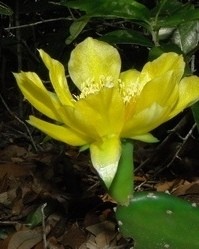Nopalea inaperta
(Nopalea inaperta)

Description
Opuntia inaperta is a species of plant in the genus Opuntia (Opuntia) from the cactus family (Cactaceae). The specific epithet inaperta means 'unopened'. Common Spanish names are "Zacam" and "Zacamsotz". Opuntia inaperta grows like a tree with loosely arranged branches and reaches heights of 4 to 7 meters. A conspicuous thorned trunk is formed. The green, clearly bumpy, obovate to elongated shoot sections are 6 to 17 centimeters long. There are three to six spines on younger areoles. They become more numerous with age. The thorns are brownish yellow and up to 2 centimeters long. The yellowish to reddish flowers reach a length of up to 4 centimeters. The red fruits are up to 1.5 centimeters long. Opuntia inaperta is distributed in the Mexican states of Campeche, Quintana Roo, Yucatán and possibly Chiapas at altitudes around 100 meters. The first description as Nopalea inaperta was in 1913 by David Griffiths. David Richard Hunt placed the species in the genus Opuntia in 1997. In the IUCN Red List of Threatened Species, the species is listed as "Least Concern (LC)". H. listed as not endangered. The development of the population is considered to be declining. Opuntia, commonly called prickly pear or pear cactus, is a genus of flowering plants in the cactus family Cactaceae. Prickly pears are also known as tuna (fruit), sabra, nopal (paddle, plural nopales) from the Nahuatl word nōpalli for the pads, or nostle, from the Nahuatl word nōchtli for the fruit; or paddle cactus. The genus is named for the Ancient Greek city of Opus, where, according to Theophrastus, an edible plant grew and could be propagated by rooting its leaves. The most common culinary species is the Indian fig opuntia (O. ficus-indica). O. ficus-indica is a large, trunk-forming, segmented cactus that may grow to 5–7 m (16–23 ft) with a crown of over 3 m (10 ft) in diameter and a trunk diameter of 1 m (1 yd). Cladodes (large pads) are green to blue-green, bearing few spines up to 2.5 cm (1 in) or may be spineless. Prickly pears typically grow with flat, rounded cladodes (also called platyclades) containing large, smooth, fixed spines and small, hairlike prickles called glochids that readily adhere to skin or hair, then detach from the plant. The flowers are typically large, axillary, solitary, bisexual, and epiperigynous, with a perianth consisting of distinct, spirally arranged tepals and a hypanthium.
Taxonomic tree:







